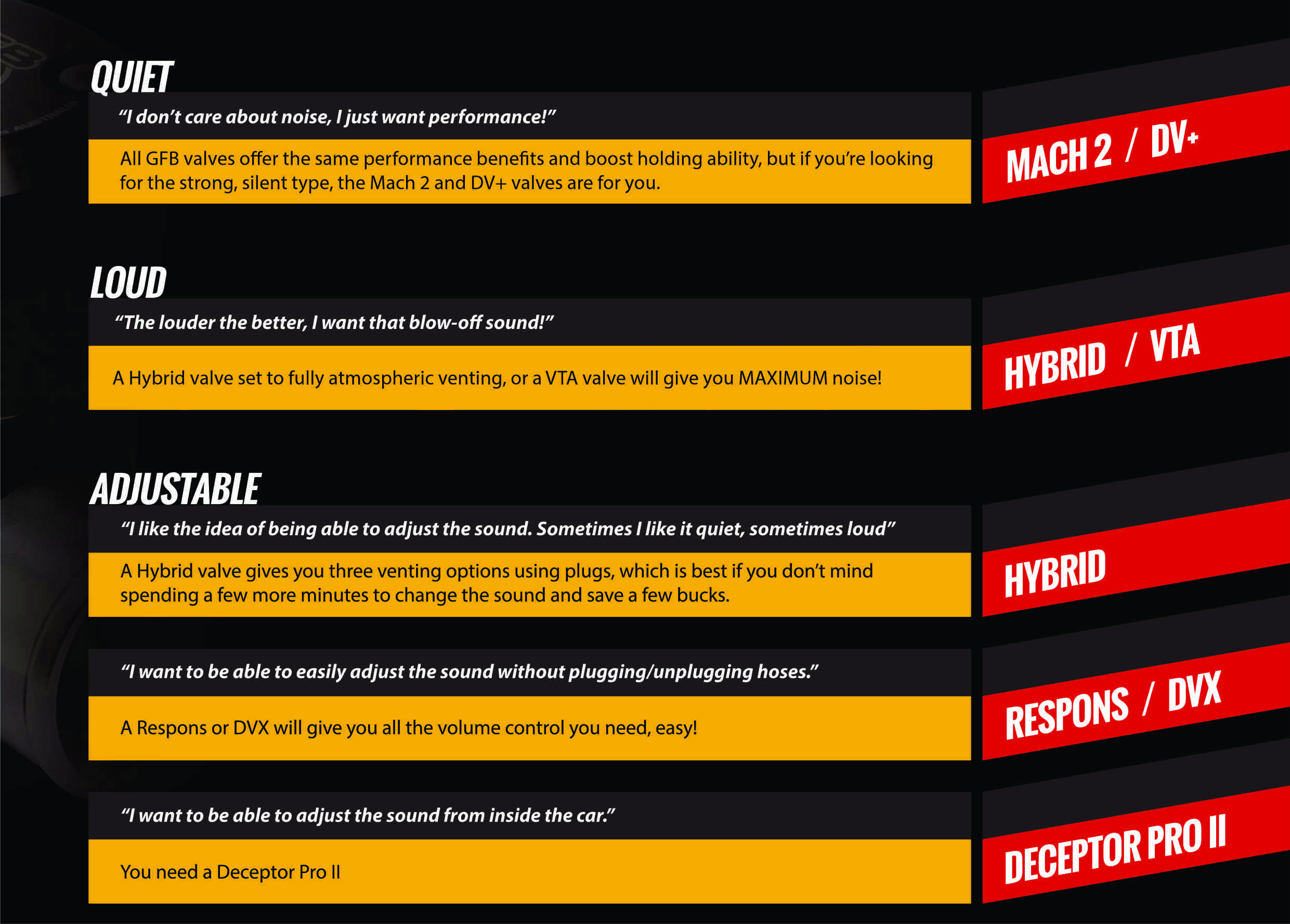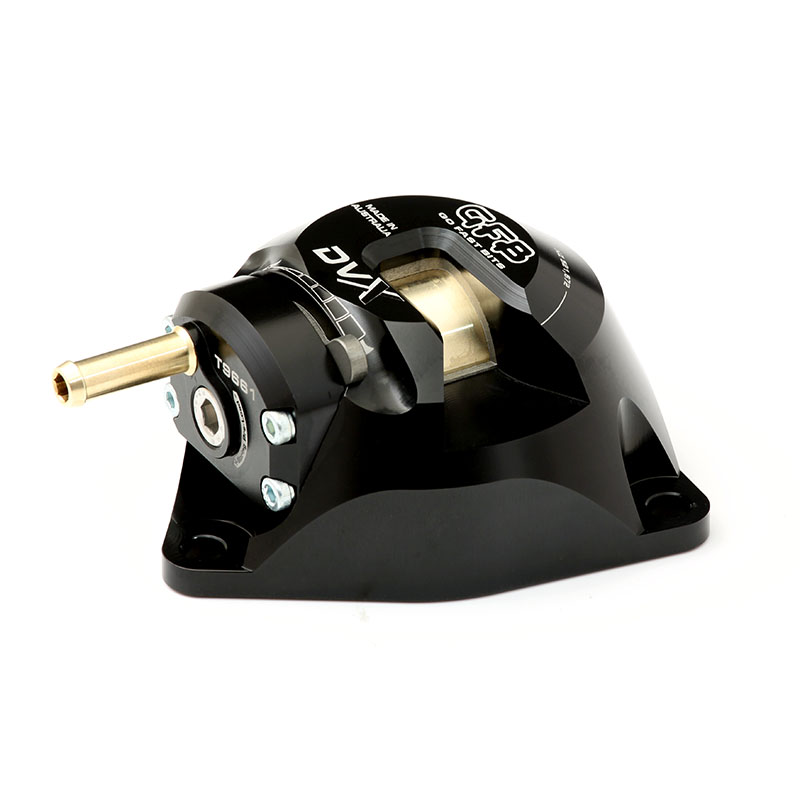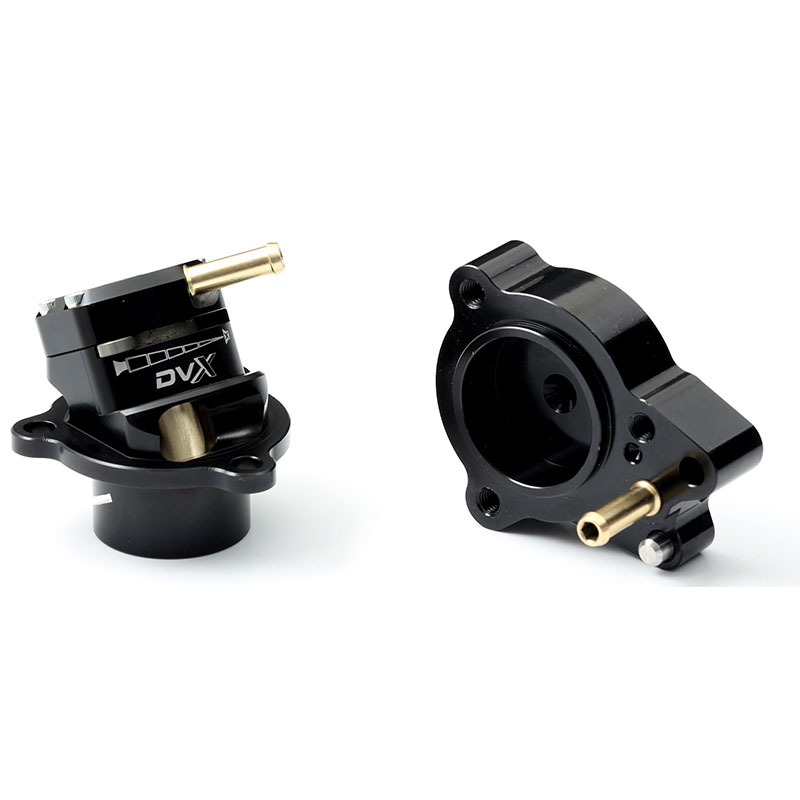You can rest assured that performance, reliability, and boost holding is built into every GFB Blow Off Valve. Our valves range considerably in fitment options, features, and price, and all are made to the same high standards when it comes to performance, you just need to select the right one for you!
You can rest assured that performance, reliability, and boost holding is built into every GFB blow off valve. Our valves range considerably in fitment options, features, and price, and all are made to the same high standards when it comes to performance, you just need to select the right one for you!
So, let’s get to it - how do I choose the right blow off valve?
The first place to start is to determine if your application is “bolt on” or “custom”.
For the purpose of this article, we’ll be focusing on the “bolt-on” applications. For any custom applications, the best thing to do is to contact one of our engineers. You can reach out to us here at [email protected], or submit a form to us on our website, and we can help determine what best suits your requirements.
A bolt on application is anywhere that the factory fitted valve is replaced, utilizing, or adapting the original mounting system. Fitting these kinds of valves is nice and simple, with no fabrication work required
Most street cars that came from the factory turbocharged and are still using the factory engine platform, will be a “bolt-on” application. We say “most” because we know there’s some of you out there who drive what could really be described as a race car to the shops (you know who you are).
If your car is a “bolt-on” application, then the next step is easy! Just put your vehicle details into the vehicle search function of our website and you’ll be presented with all the products compatible with your car.
There are multiple fitments for my car, which one is best?
Some vehicles will have multiple options for what valves fit. So, if you’ve put your vehicle details in and a whole bunch of different valves have popped up, how do you figure out which one is the right one for you?
In terms of performance all the displayed valves are the same. The only features that differentiate between them, regard the level of sound you want to pump out, and how it is adjusted.
This sound preference table will help you select the valve that gives you the sound and adjustability you want.

Your dropdowns aren’t very specific. How do I know it fits my exact vehicle?
We’ve designed the drop downs to only narrow down the search as far as it needs to go to ensure that all the vehicles that fit within that category have the same fitments. In some cases, this may be a specific year and model of car, with a specific engine option. In other cases, 10 years of the same model may all share the same fitment.
We designed it this way because we know how annoying it is when you’re at the parts store trying to get brake pads, and despite it having nothing to do with what you’re after, they ask if your car has automatic or manual transmission.
So, if you think the search options are pretty broad, it’s because the cars manufacturer used the same valve over a whole range of vehicles. As long as your car fits within the search criteria you’ve used, then you’re good to go!
Still not sure? Don’t worry, if there is something specific about your car that makes you think it’s a unique fitment, you’re welcome to contact our engineers at [email protected]. Just make sure to include some photos of your valve so we can check immediately and send you a prompt reply.
What if my car isn’t stock?
These days, most lightly to moderately modified cars will retain the original valve mounting and actuation. There are certain exceptions. For example, with Subarus that have the valve mounted directly to an intercooler, an aftermarket intercooler might require a different type of valve.
This wasn’t always the case though. In the early days of the JDM tuning scene, aftermarket manufacturers didn’t have as much of a range of direct bolt-on parts. So many aftermarket BOV’s were welded onto intercooler piping. Because of this, if you purchase a used JDM turbo car and want to purchase a GFB blow off valve, it’s a good idea to physically check what the car has when you get it.
If you know your car doesn’t have the original valve, or you just aren’t 100% sure, feel free to contact our engineers with some photos of the setup and we can help organise the right GFB BOV for you.
We carry a range of different inlet and outlet adaptors so we can help select the combination of fittings to best suit your vehicle. These also include adaptors to suit common aftermarket mountings that may have been welded onto your intake piping over the years.
I’ve got the diesel. Is it still the same valve?
Diesel engines operate a little differently than a petrol engine. A diesel engine doesn’t use a throttle in the same way that a petrol engine does. A petrol engine controls power by altering how much air enters the engine, when you lift off the pedal, the throttle snaps shut suddenly closing off the intake manifold from the charge pipe. This causes the manifold to go into vacuum and the charge pipe to spike in pressure. A diverter or blow off valve is triggered by the pressure differential between the intake manifold and the charge pipe to vent all this excess pressure.
A diesel engine controls power by altering how much fuel enters the engine, so it doesn’t need to have a throttle to limit the airflow. Because of this, a diverter valve or blow off valve is generally not needed or used. As these cars don’t have a valve from the factory, there isn’t anywhere to install an aftermarket valve without custom fabrication, and as there isn’t a throttle to put the manifold into vacuum, there isn’t any way to trigger the valve to open.
If you’re after that “whoosh” noise, a turbocharged petrol engine is your best option. Whilst it is technically possible to install a valve on a diesel engine, it will require custom fabrication work, electrical work, and programming to trigger the valve. Seeing as a valve generally isn’t needed, it tends to be something that is too difficult and expensive for the benefits you get.
My car isn’t in your vehicle search!
There could be a variety of reasons for why you can’t find your car using our search tools. For older and more common vehicles, it’s likely that we don’t have anything for that model. For rarer, newer cars however, as the variety of cars on the road grows exponentially every year, there is a chance that we were not able to confirm fitment for your vehicle yet.
If you’re uncertain, it doesn’t hurt to check with us. Please take a few photos of your stock valve and its position in your engine and email them through to us directly at [email protected], or place a ticket through our website forms here. We’ll make sure to get back to you with an answer as soon as possible!




